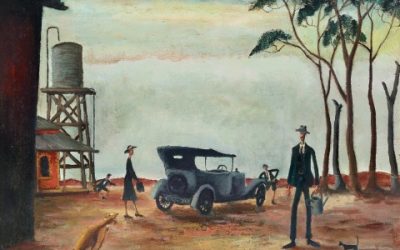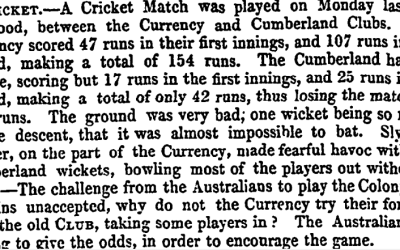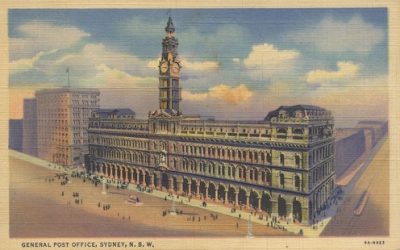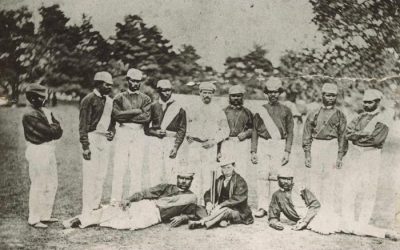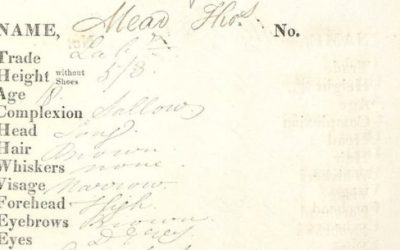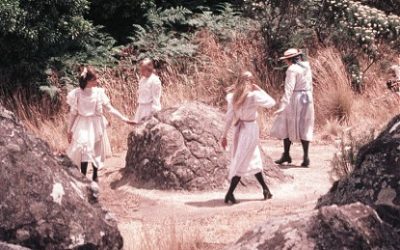Australian History
Australian Quaker Narrative Embroidery Project
Australian Quaker Narrative Embroidery Project The Australian Quaker Narrative Embroidery Project is a collection of embroidered panels designed to tell the story of The Religious Society of Friends (Quakers) in Australia, through stitch. The panels depict the history of Quakers in Australia from Sydney Parkinson on the ship Endeavour in 1770 to the present. The panels have been designed and stitched by different groups and individuals from Quaker Meetings around Australia, with some...
Vale Queen Elizabeth II (1926-2022)
The RAHS would like to offer condolences to those close to Queen Elizabeth II who are experiencing a profound personal loss at her death. As the longest-reigning monarch in British history, the late Queen will be remembered for her enormous dedication to the role she performed for more than seventy years. To commemorate her passing, the RAHS has shared images and articles of the 1954 Royal Tour of Queen Elizabeth II, when the 27-year-old Queen and her husband, Prince Philip, spent eight weeks...
Good Servants and Valuable Wives: 190 years since the arrival of the Red Rover in 1832
Written by Patrick Bourke, RAHS Member On 10 August 1832 the Red Rover arrived in Sydney Harbour with 202 free young unmarried Irish women onboard. This ship had left Cork, Ireland, on 10 April 1832. On 15 August the young women left the Red Rover and were housed in the Sydney lumber yard, which was at the southern corner of George and Bridge streets, until they could find employment. There is now a Royal Australian Historical Society green plaque on the wall of the entrance alcove of Moran...
Picturing Post-War Reconstruction at a Local Level
National Threatened Species Day
Written by Elizabeth Heffernan, RAHS Intern On 7 September 1936, Benjamin, the world’s last known thylacine, died in captivity at Hobart Zoo from suspected neglect. Despite decades of a rapidly dwindling population, hastened by habitat destruction, disease, the incursion of introduced species, and human intervention, the species had only been declared protected two months prior. It would take fifty years before the thylacine—better known as the Tasmanian tiger after the distinctive stripes...
Changing times: 50 years of daylight saving
Written by Elizabeth Heffernan, RAHS Intern Daylight saving is an accepted, if confusing, part of life for most Australians. On the first Sunday in October, people living in New South Wales, Victoria, South Australia, Tasmania, and the Australian Capital Territory set their clocks forward by one hour to extend daylight hours after the working day. On the first Sunday in April, we set them back. The practice is a controversial one, neatly illustrated by the five time zones daylight saving...
Exciting New World: Australia in the 1920s
Written by Elizabeth Heffernan, RAHS Volunteer On Saturday 6 November 2021, the RAHS held a special online event, exploring the Exciting New World: Australia in the 1920s and 1930s. This is the first in a series of two blog posts about the interwar decades, providing an overview of the broad spectrum of changes that occurred across Australian politics, society, and culture during that time. Read the second instalment here ‘… the power of the modern … simultaneously exhilarated and alarmed the...
Ninnis, Mertz, and Mawson
Written by Elizabeth Heffernan, RAHS Intern 110 years ago in 1911, the Australasian Antarctic Expedition (AAE) set sail from Hobart, Tasmania, on the old whaling ship Aurora. Among the crew were a young Frank Hurley, soon-to-be war photographer; Frank Wild, English explorer and Antarctic veteran; Belgrave Ninnis, son of the Arctic explorer of the same name and lieutenant with the Royal Fusiliers; Xavier Mertz, Swiss champion skier; and Douglas Mawson, Australian geologist and leader of the...
Remembering Regional City 75th Anniversaries, 2020-2022
Women’s Protests: Then and Now
By Elizabeth Heffernan, RAHS Intern On Monday 15 March 2021, thousands of protestors attended more than forty ‘March 4 Justice’ events across the country. From Melbourne to Mullumbimby, participants rallied against the virulent culture of gendered violence, harassment, and discrimination that plagues even the highest offices of federal parliament. They wore black and carried placards denouncing misogyny, domestic violence, rape culture, and sexual abuse in the workplace. Their rallying cry was...
‘The Penny Gaff’: A New Historical Resource
The circus is a rich and vibrant part of Australian cultural history that continues to flourish in many different forms today. Some of the most famous international circus stars of the twentieth century were Australian; at the height of the industry, 17 large circuses were travelling the country at once. Dive into the lives, travelling routes, performances and more of our country’s most celebrated circus troupes in Mark St Leon’s new website, ‘The Penny Gaff’, dedicated to the history of...
Exciting New World: Australia in the 1930s
Written by Elizabeth Heffernan, RAHS Volunteer On Saturday 6 November 2021, the RAHS held a special online event, exploring the Exciting New World: Australia in the 1920s and 1930s. This is the second in a series of two blog posts about the interwar decades, providing an overview of the broad spectrum of changes that occurred across Australian politics, society, and culture during that time. Read the first instalment here If the 1920s was a decade defined by change, the 1930s was one of...
Outside Off – My Brother Jack
Written by Maximilian Reid, RAHS Volunteer‘ ‘Our Don Bradman’ Australian stories flow with cricket. Perhaps none more so than Donald Bradman, whose bronze statues, street names and ubiquitous average of 99.94 are full throated in their praise. This edition of Outside Off is not. In keeping with past editions, we seek to illustrate Australian society through cricket afforded by cricket’s unique moral dimensions. One of the most complex moral dimensions of cricket and one mirrored in today’s is...
‘This is the ABC’
Written by RAHS volunteer Elizabeth Heffernan On Friday, 1 July 1932, after the 8pm bells of Sydney’s General Post Office, Conrad Charlton announced to the country: “This is the Australian Broadcasting Commission.” [1] It was the ABC’s first wireless radio broadcast after the Australian Broadcasting Commission Act 1932 was passed on 17 May. The transmission is estimated to have reached 6% of the country’s population at the time—almost 400 000 people from as far away as Perth. [2] The leaders...
Outside Off – Riot of 1879
Riot, Bets and Class Cricket is now the prevailing amusement of the day. Let no man henceforth set up for a sporting character whose name is not enrolled among the ‘gentlemen cricketers’ of Sydney”[1] The Sydney Gazette, on the formation of a new cricket club, 1832. Victorian gentility, civility, and sobriety. If there is ever an image to be conjured of early colonial cricket, it seems to be this one. [2] However, early colonial cricket in Sydney was coarse. Inter-colonial rivalry, gambling,...
Anzac Day 1918: Different, but not forgotten
Written by Elizabeth Heffernan, RAHS volunteer The twice-a-day Amiens train rattles into Villers-Bretonneux station, dead autumn leaves swept to the sides of the platform and rusted overpass looming above the tracks. The small, French village is silent, cobbled streets empty in the early morning gloom. Google Maps points the way past the houses and into the fields beyond; the path laid out before us is slippery with mud and wet cut grass. Fresh rain promises. It is three kilometres from the...
Outside Off – Aboriginal Tour of England 1868
Written by RAHS Volunteer Maximilian Reid. This blog is part of a monthly series that will chart episodes of cricketing history to demonstrate how the arcs of societal change and cricket intersect. The creation of cricket, a sport for the landed English gentry, has been levelled and is now played and enjoyed by all. It was certainly not intended this way and the arcs by which societal change and cricket intersect is neither simple nor easy. Cricket, despite being traditionally a conservative...
Convict Flash Language
Written by RAHS Volunteer and Copywriter Christina King This blog post is part of a series entitled ‘The Convict Experience: Love, Life and Liberty Beyond the Chains’. Each month we will explore a different – and often rather unusual – type of primary evidence historians can use to hear convict voices telling their own stories. Previous editions on Convict Tattoos and Love Tokens are still available to read online. What was flash language and who used it? Originating in the criminal underworld...
Convict Love Tokens
Written by RAHS Volunteer and Copywriter, Christina King This blog post is part of a series entitled ‘The Convict Experience: Love, Life and Liberty Beyond the Chains’. Each month we will explore a different – and often rather unusual – type of primary evidence historians can use to hear convict voices telling their own stories. Movingly known as ‘leaden hearts’[1] and ‘likened to portable graffiti’[2], convict love tokens have been described as ‘a unique chance to see the convicts as they saw...
Convict Tattoos
Written by RAHS Volunteer and Copywriter, Christina King This blog post is part of a series entitled ‘The Convict Experience: Love, Life and Liberty Beyond the Chains’. Each month we will explore a different – and often rather unusual – type of primary evidence historians can use to hear convict voices telling their own stories. Revisionist history has done a significant job redefining convict history as more than simply an account of troublesome prisoners shipped to a foreign land. Primary...
Valentine’s Day 1900
Written by Elizabeth Heffernan, RAHS Volunteer On Valentine’s Day in 1900, two schoolgirls and their maths teacher went missing from a picnic at Hanging Rock and were never seen again – or so author Joan Lindsay led her readers to believe in the classic Australian novel Picnic at Hanging Rock, first published in 1967. A short note from the author prefaces the story: “Whether Picnic at Hanging Rock is fact or fiction, my readers must decide for themselves. As the fateful picnic took place in...
An anthem “of our own”: Advance Australia Fair
Written by RAHS volunteer, Elizabeth Heffernan In 1878, Scottish-born Australian composer Peter Dodds McCormick wrote the music and lyrics to a new patriotic song, ‘Advance Australia Fair’. One hundred and six years later, on 19 April 1984, his song – amended to suit a more modern audience – was adopted as the new Australian national anthem, replacing ‘God Save the Queen’. Today, ‘Advance Australia Fair’ is unquestionably played at local, national, and international political, cultural, and...




